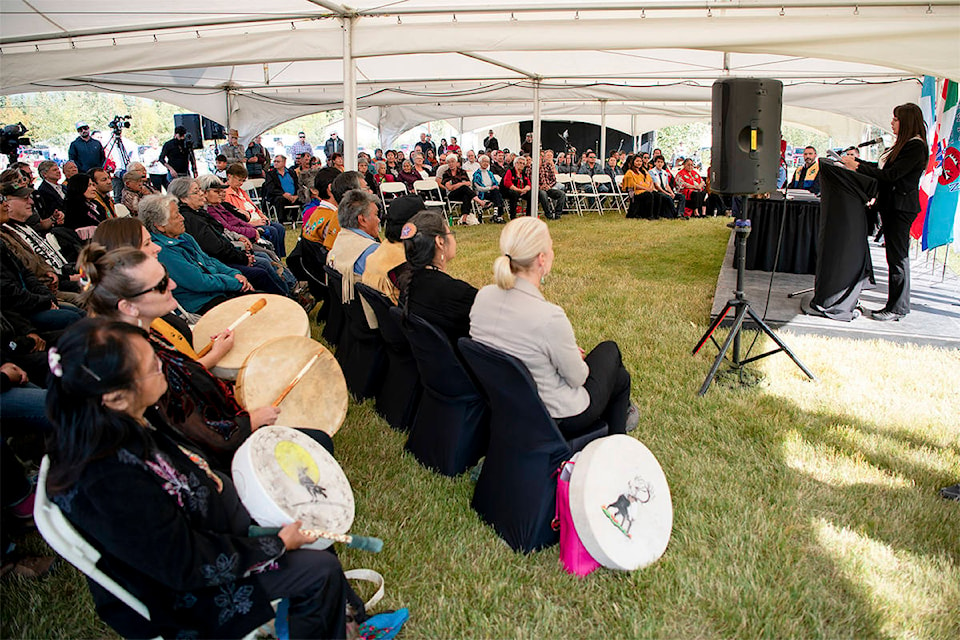The vast majority of the Peel watershed is protected, ending years of uncertainty and undoing changes that would have pried the area wide open to possible development.
It’s a change that “will resound through the ages,” said Simon Mervyn, chief of the First Nation of Na-Cho Nyäk Dun, on Aug. 22, the day Yukon leaders signed off on the final land use plan.
Leaders from the Tr’ondëk Hwëch’in, Vuntut Gwitchin First Nation, Gwich’in Tribal Council and the Yukon government had all gathered in Mayo for the ceremony. Many touted the event as “historic” and “precedent-setting.”
“After 15 years of controversy that led all the way to the Supreme Court of Canada, we have confirmed the integrity of our final agreements and the rights of our people to sit at the decision-making table when the fate of our ancestral lands is determined,” Mervyn said. “Thanks to all the good people who stood beside us and thanks, also, to the Yukon government, who, at the end of the day, saw the light and joined us.”
He said it’s one of the “longest and most difficult roads” the First Nation has gone down.
“We have decided that the long-term spiritual health of our people is more important than short-term economic gains, and that our grandchildren deserve clean, natural glaciers in which to hunt, play and pray. This was the vision of our chiefs, who presented Together Today for our Children Tomorrow to Prime Minister Trudeau, Justin’s dad, back in 1973.”
Eighty-three per cent of the region is now designated conservation land.
Compared to the recommended plan, which was created in 2011, there’s more land that’s now protected — 2,069 square kilometres more, intended to safeguard habitat of the boreal caribou.
The region is comprised of 16 management blocks built into four land designations, three of which offer three varying degrees of protection. Fifty-five per cent is to be permanently set aside; 25 per cent has interim projection and will be subjected to joint review every 10 years, at least. Caribou habitat protection, at three per cent, is a subset of the latter, categorized as a “Wilderness Area.”
The remainder (17 per cent) is open to some new industrial projects. According to the plan, these include oil and gas extraction, mining and roads.
“These uses are subject to plan recommendations and regulatory processes,” it says.
The area is 67,431 square kilometres. The region where potential projects could spring up is 11,573 square kilometres.
“Different zones allow varying levels of development and surface disturbance,” says a summary of the plan (there are four zones.) “Proposed projects will need to go through the normal regulatory and assessment processes.
“After new roads and trails are no longer needed, they must be reclaimed. Development thresholds will be set. Impacts will be monitored and limited as they accumulate.”
The final plan still needs to be implemented. In order to do this, a committee comprised of members from each party will be created.
Asked when the committee will be struck, Jesse Devost, spokesperson with the Department of Energy, Mines and Resources, said “immediately.”
On the radar for the process includes writing the designated areas into law and creating management plans for each.
“Tomorrow we cross the river, but tonight we dance,” said Premier Sandy Silver during a press conference.
Any changes going forward must occur in lockstep with other governments, he said.
“All conversations and issues have to be dealt with government-to-government-to-government, everybody has to be in line,” Silver said. “One government disagreeing is one thing, but if you’re gonna do any type of significant change at all, it has to be with the blessing of all First Nations and the territorial government at the same time.”
Last year, the Yukon branch of the Canadian Parks and Wilderness Society was calling for 80 per cent of the area to be permanently protected.
But raising the bar has dispelled concerns when it comes to land that’s secured interim protection, according to its executive director.
“It will now require a full plan review,” Chris Rider said. “That gives me confidence, that unless circumstances change, that important piece of land will remain protected for the foreseeable future. It will require consensus among the parties in order for that to change.”
There are thousands of mineral claims in the area. According to the final plan, there are roughly 8,400 active quartz claims alone.
“No new industrial land use or surface access is allowed (in the conservation area),” it says. “Existing mineral claims or leases may be respected, and pre-existing non-industrial land uses are respected.”
It was a Liberal election promise to implement the recommended plan.
It’s required a lot of stamina to get this far – protests and disputes drawn out in courtrooms. Scraps of this time still adorn people’s bumpers with “Protect the Peel” stickers.
In 2017, the Supreme Court of Canada ruled that a plan released by the Yukon Party in 2014 significantly deviated from the Final Recommended Plan produced by the Peel Watershed Planning Committee a few years earlier.
All three levels of court agreed that the Yukon Party government overstepped when it tried to implement a final plan that nearly reversed the amount of protected land.
The former government’s plan involved 71 per cent of the watershed being available for extraction purposes and 29 per cent of it protected.
First Nations and environmental organizations took the government to court arguing that making those kinds of significant changes did not align with the land-use process laid out in Section 11 of the First Nations’ final agreements.
The Supreme Court ordered the territorial and First Nations governments go back and do one last round of consultations with the caveat that only minor changes could be made to the recommended plan.
Public consultation opened September 2018. Over 2,000 comments were received.
Contact Julien Gignac at julien.gignac@yukon-news.com
